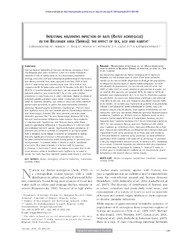Приказ основних података о документу
Intestinal helminths infection of rats (ratus norvegicus) in the Belgrade area (Serbia): the effect of sex, age and habitat
| dc.creator | Kataranovski, Milena V | |
| dc.creator | Mirkov, Ivana | |
| dc.creator | Belij, Sandra | |
| dc.creator | Popov, Aleksandra D | |
| dc.creator | Petrović, Z | |
| dc.creator | Gačić, Zoran | |
| dc.creator | Kataranovski, Dragan S | |
| dc.date.accessioned | 2022-04-05T14:31:54Z | |
| dc.date.available | 2022-04-05T14:31:54Z | |
| dc.date.issued | 2011 | |
| dc.identifier.issn | 1252-607X | |
| dc.identifier.uri | http://rimsi.imsi.bg.ac.rs/handle/123456789/501 | |
| dc.description.abstract | Gastrointestinal helminths of Norway rat (Rattus norvegicus) from the Belgrade area were studied as a part of a wider ecological research of rats in Serbia (data on the distribution, population ecology, economic and epizoothiological-epidemiological importance, and density control). Rats were captured from May 2005 to July 2009 at both urban and suburban-rural sites. Of a total of 302 trapped rats 48 % were males and 52 % females, with 36.5 % and 38.8 % of juvenile-subadult individuals, per sex respectively. Intestinal helminth infection was noted in 68.5 % of rats, with a higher prevalence in male hosts and in adult individuals. Higher numbers of infected juveniles-subadults were noted in suburban-rural habitats, while an opposite tendency was noted in adult rats. Seven helminth species were recovered, of which five were nematode (Heterakis spumosa, Nippostrongylus brasiliensis, Capillaria sp., Trichuris muris and Syphacia muris) and two cestode species (Hymenolepis diminuta and Rodentolepis fraterna). The most prevalent parasites were Heterakis spumosa (36.7 %) and Hymenolepis diminuta (30.5 %). Sex and habitat-related differences were noted in the prevalence of infection with Capillaria sp. and Trichuris muris, while there were no age-related differences in the prevalence of infection with any individual helminth species. Significantly higher prevalence of infection was noted in summer as compared to spring or winter, with a tendency to be higher in autumn as compared to spring. The only significant difference in the prevalence of infection between habitat-related was noted during spring. H. spumosa was most prevalent in summer, while H. diminuta and N. brasiliensis in autumn. The mean intensity of infection with H. spumosa, R. fraterna, S. muris and I muris was higher in autumn than in the other seasons, while N. brasiliensis and Capillaria sp. occured in winter. No more than four helminth species were found in one host. | en |
| dc.publisher | Edp Sciences S A, Les Ulis Cedex A | |
| dc.relation | info:eu-repo/grantAgreement/MESTD/MPN2006-2010/143038/RS// | |
| dc.rights | openAccess | |
| dc.rights.uri | https://creativecommons.org/licenses/by/4.0/ | |
| dc.source | Parasite | |
| dc.subject | Serbia | en |
| dc.subject | Rattus norvegicus | en |
| dc.subject | nematodes | en |
| dc.subject | intestinal helminths | en |
| dc.subject | cestodes | en |
| dc.title | Intestinal helminths infection of rats (ratus norvegicus) in the Belgrade area (Serbia): the effect of sex, age and habitat | en |
| dc.type | article | |
| dc.rights.license | BY | |
| dc.citation.epage | 196 | |
| dc.citation.issue | 2 | |
| dc.citation.other | 18(2): 189-196 | |
| dc.citation.rank | M23 | |
| dc.citation.spage | 189 | |
| dc.citation.volume | 18 | |
| dc.identifier.doi | 10.1051/parasite/2011182189 | |
| dc.identifier.fulltext | http://rimsi.imsi.bg.ac.rs/bitstream/id/719/498.pdf | |
| dc.identifier.pmid | 21678796 | |
| dc.identifier.scopus | 2-s2.0-80052052553 | |
| dc.identifier.wos | 000291240500011 | |
| dc.type.version | publishedVersion |

